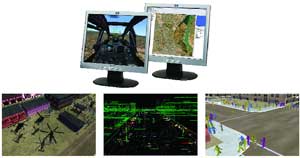Target identified

Simulation technology paints a real picture of live combat.
Simulation technologies are changing the way the military trains fighting forces by allowing greater versatility and far more expansive scenarios than would be possible using real hardware.An Air Force exercise using real planes might, for example, pit 16 pilots against one another, eight playing U.S. forces and the other eight challenging them as the enemy.An exercise using simulation technology, by contrast, might involve thousands of planes and other objects or devices that combine real planes, pilots in simulators and completely computer-generated entities.The Air Force is using the Stage Scenario toolkit from Montreal-based Engenuity Technologies Inc. to create blue forces ? the good guys ? and testing them against red enemy forces created with a tool called the Next Generation Threat System."Now we take those blue air pieces and those red air pieces, and together we construct a more robust environment than these folks will ever be able to see in a live-fly event, or even in a strictly virtual event," said Capt. D'Artagnan de Anda of the Distributed Mission Operation Center (DMOC) at Kirtland Air Force Base."The environment generators that we have make more robust events that provide [a] more challenging and realistic training environment for theater-level engagements."Stage Scenario is the simulation engine that drives the virtual environment. It continuously calculates how all the entities in a virtual environment would interact. It determines where things should be positioned from one instant to the next, including vehicles, people and weather patterns."So the whole environment you find is essentially generated by Stage Scenario," said Robert Kopersiewich, director of product managment at Engenuity Technologies.Stage Scenario gets input from actual pieces of equipment ? including aircraft and flight simulators ? in addition to computer-generated input. In the simulation world, protocols have been established to enable communication via a geographically diverse network.Those protocols allow DMOC to run exercises with participants in different parts of the United States and sometimes with allied countries worldwide."What Stage Scenario does is sit in one place and communicate through these protocols to the different nodes in this network," Kopersiewich said. "And for each one of those nodes, you will have different participants taking part in the exercise."Advances in hardware and software have enabled the simulations to become highly complex. Once it took a powerful, dedicated piece of hardware to run a complicated simulation. Now a product such as Stage Scenario can run on a high-end PC with a good graphics card and processor.Concurrently, the software has been optimized to run larger simulations.Using this technology, the Air Combat Command, the Air Force's largest command, oversees quarterly exercises called Virtual Flag. DMOC acts as the hub of the event and creates the environments. A typical exercise can simultaneously include 25 to 30 distributed locations.The complexity the system enables is important because it more closely mirrors an actual conflict than an exercise of all-live participants ever could.About 30 operators at DMOC run the computer-generated entities, called constructive entities."So as this virtual guy is flying in his virtual simulator cockpit, [he] calls out a call sign to a constructive entity, but he won't know whether that entity is constructive or whether that entity is virtual," de Anda said.It is impossible for a participant to tell whether another entity is real, simulated or constructed in a computer.One of the biggest challenges in building the exercises is determining how real some entities need to be. For example, some computer-generated planes just need to appear as dots on a radar screen to create the realistic features of battle. Others need to be more realistic to coincide with the training objectives of a particular exercise.The subtleties are successfully being applied in today's events, de Anda said."We had a guy come in and say this particular environment is the most realistic environment that he had participated in since he flew in Desert Storm," de Anda said.

Staff writer Doug Beizer can be reached at dbeizer@1105govinfo.com.

Air Force combat exercises use a simulation engine called Stage Scenario from Engenuity Technologies Inc. The system helps train pilots for complex, large-scale action that goes well beyond what they would receive in live training or older simulation events.
Staff writer Doug Beizer can be reached at dbeizer@1105govinfo.com.
NEXT STORY: Harris makes play for Multimax